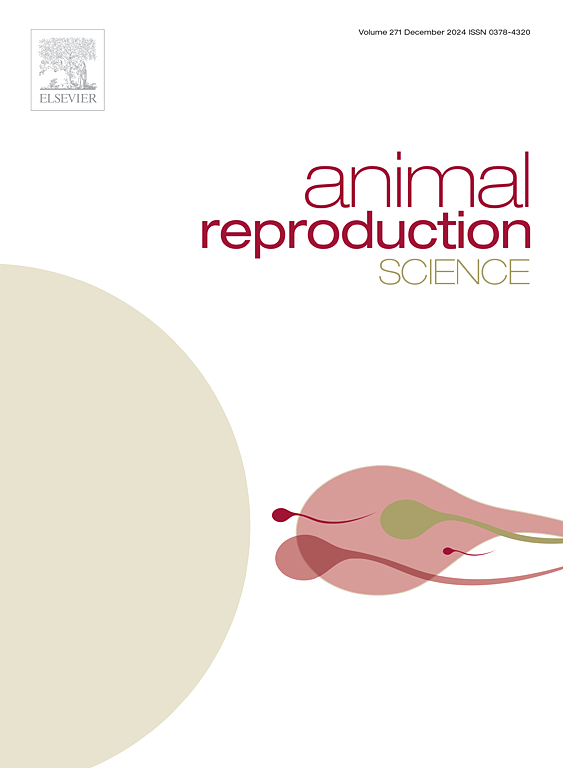在常规慢速冷冻和动态玻璃化培养基中添加白藜芦醇对犬附睾精子冷冻后质量的影响
IF 2.2
2区 农林科学
Q1 AGRICULTURE, DAIRY & ANIMAL SCIENCE
引用次数: 0
摘要
白藜芦醇(Resveratrol, RES)是一种强大的抗氧化剂,最近被证明可以通过不同的冷冻保存方法提高精子的存活率。本研究评估了在常规慢速冷冻(CS)和动态玻璃化(VIT)培养基中添加RES对犬精子质量变量的影响。从30只切除睾丸的成年犬中收集20份精子样本(3份附睾/池)。在每个合并样本中,根据补充RES(对照[未添加]或100 µM)和冷冻保存方法(CS或VIT)建立4种处理:CS- control、CS+RES、VIT- control和VIT+RES。CS冷冻是通过将0.25 ml吸管中的精子样品暴露于液氮(LN₂)蒸汽中进行的。将30 µl精子液滴直接浸入LN₂中进行玻璃化。结果初步表明,在精子运动学和膜完整性方面,VIT处理产生的结果与CS冷冻相似。与CS- control处理相比,CS+RES处理的精子样品在活力、活力、顶体完整性和DNA完整性方面显示出更高的百分比(P <; 0.05)。此外,与CS- control和VIT- control处理相比,CS+RES和VIT+RES处理的精子DNA断裂率均较低(P <; 0.05)。尽管如此,RES对玻璃化后的某些运动学参数(如速度、直线度和跳动交叉频率)和精子头尺寸产生了负面影响。总之,白藜芦醇提高了精子活力、活力和顶体完整性,减少了传统慢速冷冻后的DNA断裂。虽然它也减少了玻璃化后的DNA碎片化,但它对狗附睾精子的运动学产生了负面影响。本文章由计算机程序翻译,如有差异,请以英文原文为准。
Effect of resveratrol supplementation in conventional slow freezing and kinetic vitrification media on the post-cryopreserved quality of dog epididymal spermatozoa
Resveratrol (RES) is a powerful antioxidant that has recently been shown to improve sperm survival subjected to different cryopreservation methods. This study evaluated the effect of RES supplementation in conventional slow (CS) freezing and kinetic vitrification (VIT) media on dog sperm quality variables. Twenty pooled sperm samples from 30 orchiectomized adult dogs were used (three epididymal samples / pool). In each pooled sample, four treatments were established based on RES supplementation (control [no added] or 100 µM) and the cryopreservation method (CS or VIT): CS-Control, CS+RES, VIT-Control and VIT+RES. The CS freezing was performed by exposing sperm samples in 0.25 ml straws to liquid nitrogen (LN₂) vapors. Vitrification was made by directly submerging 30 µl sperm droplets into LN₂. The results initially demonstrated that VIT treatments produced outcomes similar to those of CS freezing in terms of sperm kinematics and membrane integrity. Sperm samples from the CS+RES treatment showed higher percentages (P < 0.05) of motility, viability, acrosomal integrity, and DNA integrity compared to those from the CS-Control treatment. Furthermore, both CS+RES and VIT+RES treatments obtained a lower percentage (P < 0.05) of sperm DNA fragmentation compared to both CS-Control and VIT-Control treatments. Despite this, RES negatively affected certain kinematic parameters (e.g., velocities, straightness, and beat cross frequency) and sperm head dimensions after vitrification. In conclusion, resveratrol improved sperm motility, viability, and acrosomal integrity and reduced DNA fragmentation following conventional slow freezing. While it also reduced DNA fragmentation after vitrification, it negatively affected sperm kinematics in dog epididymal sperm.
求助全文
通过发布文献求助,成功后即可免费获取论文全文。
去求助
来源期刊

Animal Reproduction Science
农林科学-奶制品与动物科学
CiteScore
4.50
自引率
9.10%
发文量
136
审稿时长
54 days
期刊介绍:
Animal Reproduction Science publishes results from studies relating to reproduction and fertility in animals. This includes both fundamental research and applied studies, including management practices that increase our understanding of the biology and manipulation of reproduction. Manuscripts should go into depth in the mechanisms involved in the research reported, rather than a give a mere description of findings. The focus is on animals that are useful to humans including food- and fibre-producing; companion/recreational; captive; and endangered species including zoo animals, but excluding laboratory animals unless the results of the study provide new information that impacts the basic understanding of the biology or manipulation of reproduction.
The journal''s scope includes the study of reproductive physiology and endocrinology, reproductive cycles, natural and artificial control of reproduction, preservation and use of gametes and embryos, pregnancy and parturition, infertility and sterility, diagnostic and therapeutic techniques.
The Editorial Board of Animal Reproduction Science has decided not to publish papers in which there is an exclusive examination of the in vitro development of oocytes and embryos; however, there will be consideration of papers that include in vitro studies where the source of the oocytes and/or development of the embryos beyond the blastocyst stage is part of the experimental design.
 求助内容:
求助内容: 应助结果提醒方式:
应助结果提醒方式:


